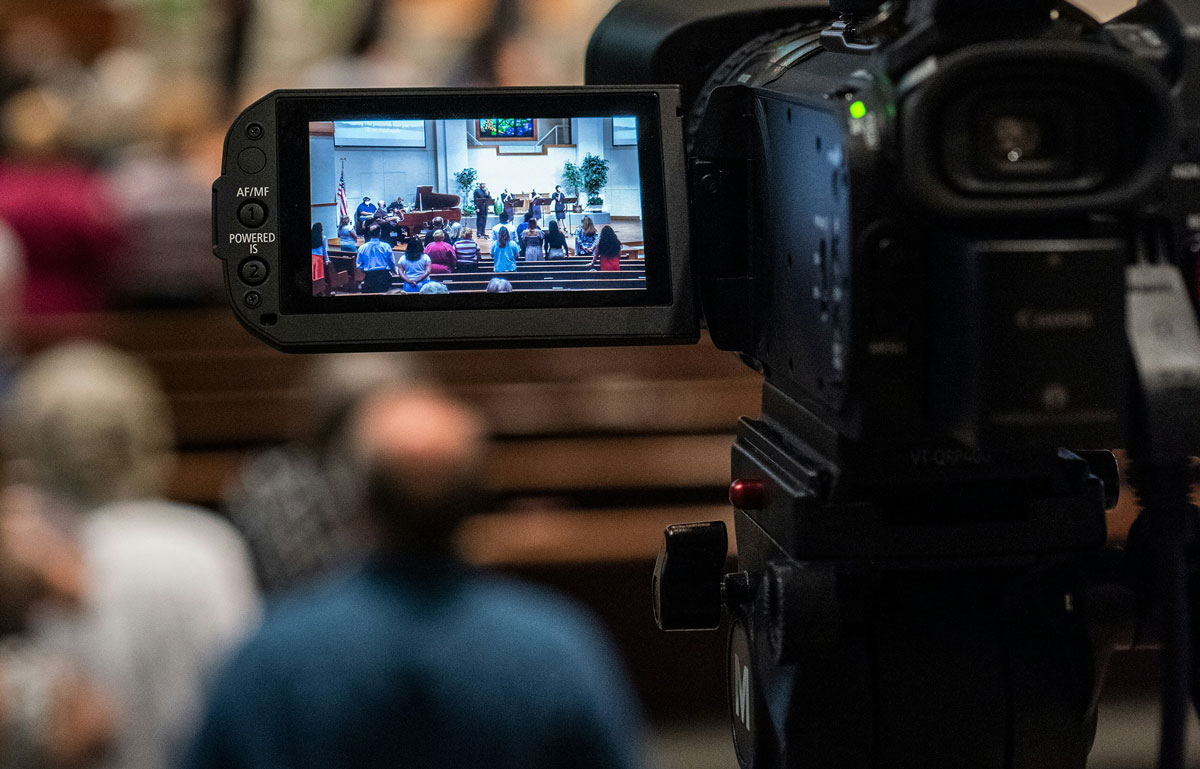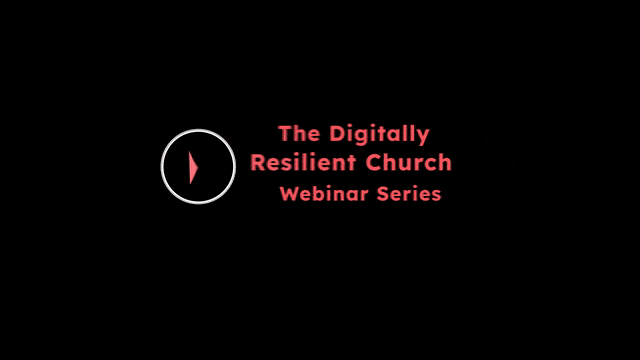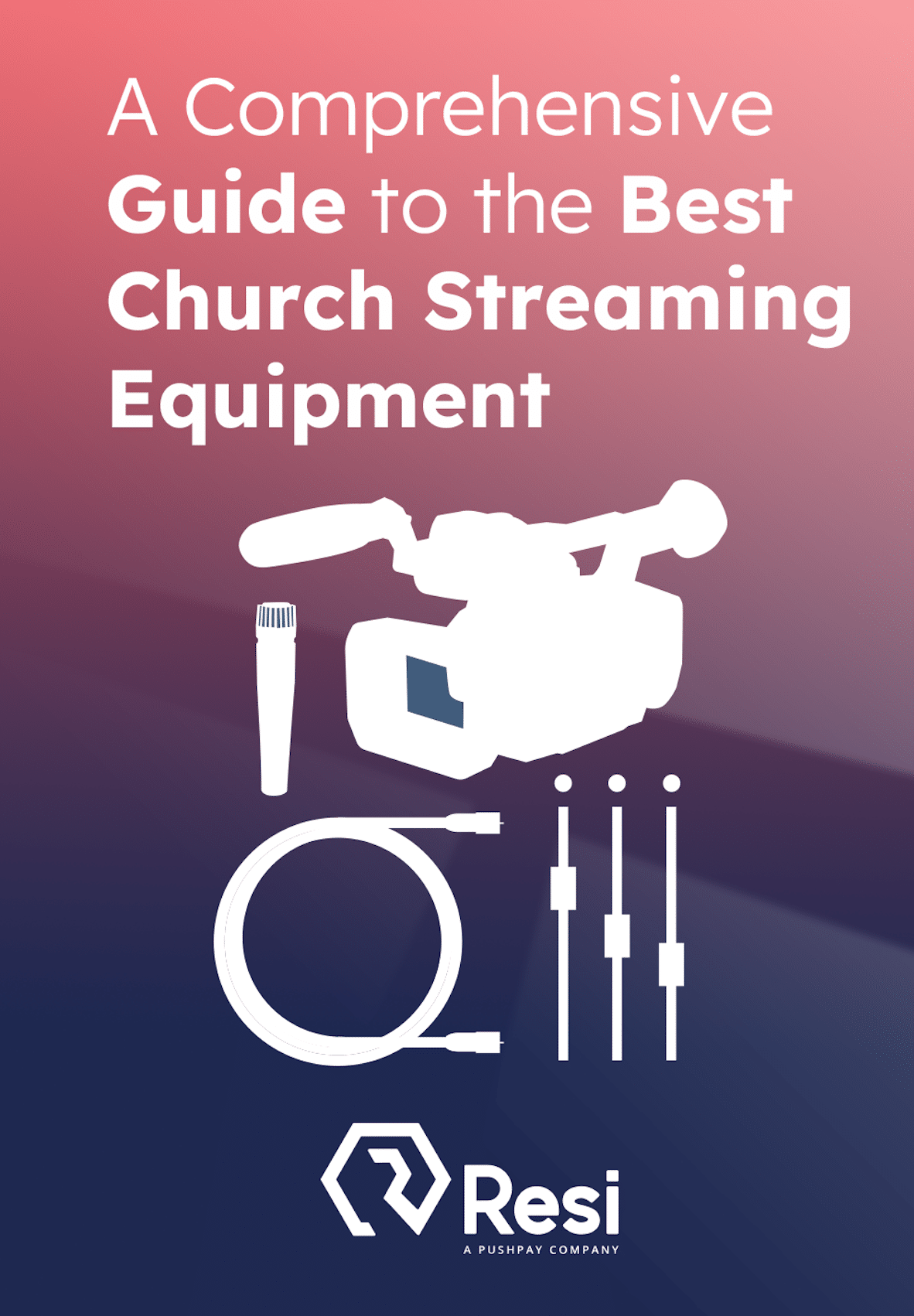
It’s Easter morning and your tech director is watching the viewer count climb—500, 750, 1,000—higher than you’ve ever seen. Then the complaints start rolling in. Buffering. Audio cutting out. The stream freezing at the exact moment your pastor delivers the most important message of the year.
This isn’t a technical failure. It’s a sign your ministry is working. Your message is reaching people. Your online congregation has grown beyond what your current streaming setup can handle. The good news? That’s exactly the kind of problem you want to have.
When your streaming equipment maxes out, you’re not facing a crisis. You’re standing at a growth threshold. The question isn’t whether to upgrade—it’s how to scale smartly without breaking the bank or overwhelming your volunteer team, recognizing when it’s time to upgrade, understanding your hardware options, and building an infrastructure that grows with your ministry.
When Your Streaming Setup Can’t Keep Up
Your streaming hardware will tell you when it’s struggling—you just need to know what to listen for. The clearest signal comes directly from your viewers: comments about buffering during peak attendance times, complaints about choppy video quality, or reports that the stream dropped right before the sermon. These aren’t random glitches. They’re symptoms of a system running beyond its capacity.
Behind the scenes, your encoder offers its own warning signs. If your hardware is running hot to the touch, pushing CPU usage consistently above 80%, or requiring frequent restarts, you’ve maxed out its capabilities. The difference between a software limitation and a hardware bottleneck comes down to this: software issues show up randomly across different times and viewer counts, while hardware bottlenecks appear predictably when you hit certain thresholds.
Your analytics tell the story too. When your concurrent viewer count has doubled in six months, when your bandwidth usage spikes beyond what your internet connection can reliably handle, or when Easter and Christmas services bring your stream to its knees—these metrics signal that your hardware can’t keep pace with your growth.
The cost of waiting too long goes beyond poor video quality. Every buffer wheel represents a viewer who might not come back next week. Every dropped stream damages the trust you’ve built with your online congregation. Churches that proactively upgrade maintain consistent quality through growth seasons. Those that wait often scramble to fix problems during the exact moments when streaming matters most. A congregation that went from 500 to 2,000 weekly online viewers without upgrading their encoder learned this lesson the hard way—three consecutive Sunday failures before they invested in church live streaming services that could handle their actual audience size.
Hardware Encoders vs. Software: What Growing Churches Need
Hardware encoders exist for one reason: reliability when it matters most. Unlike software running on a general-purpose computer, dedicated hardware encoders do one job and do it consistently. No antivirus scans interrupting your stream mid-sermon. No Windows updates forcing a restart during your Christmas Eve service. No competing programs stealing processing power when your viewer count peaks.
The reliability advantage comes from simplicity. Hardware encoders run embedded operating systems designed specifically for video encoding. They boot faster, run cooler, and eliminate the computer crashes that plague software-based streaming setups. For churches where streaming has moved from experimental to essential, hardware encoders deliver the consistency that your online congregation deserves.
Growing churches face a fundamental choice in how they scale their streaming infrastructure. Each path offers distinct advantages depending on your priorities, technical capacity, and ministry context.
Hardware Encoders for Maximum Reliability
Dedicated encoding hardware transforms streaming from a technical challenge into a solved problem. Professional server-grade hardware provides the highest reliability available for live streaming, designed specifically for organizations where streaming failure isn’t acceptable. These encoders handle the full encoding process independently—no computer required, no multitasking compromises, no mysterious crashes during your biggest services.
The practical impact shows up most clearly during high-pressure moments. When you’re streaming a wedding, a memorial service, or your Easter gathering, hardware encoders simply work. Tech directors who’ve made the switch describe the difference as moving from constant anxiety to genuine confidence. Your volunteer team can focus on camera work and audio mixing instead of troubleshooting encoder crashes.
Software Encoders for Budget-Conscious Growth
Software-based encoding still serves churches strategically managing their budget. The upfront investment stays lower since you’re leveraging computer hardware you already own. Modern encoding software integrates directly with production tools like ProPresenter, creating streamlined workflows that reduce complexity for volunteer operators.
The tradeoff comes in stability. Software encoders share system resources with every other program running on that computer. When your encoding computer doubles as your presentation machine, both functions compete for processing power. Churches using software encoders successfully tend to dedicate a separate, powerful computer exclusively to streaming—which quickly approaches the cost of entry-level hardware encoders anyway.
Cloud-Based Solutions
Pre-recorded video livestreaming removes hardware dependency entirely for specific use cases. Upload your fully produced video content, schedule when it streams to multiple destinations, and let cloud infrastructure handle the distribution. This approach works brilliantly for supplementing your live streaming strategy—replaying last week’s message on weeknights, broadcasting special content to satellite locations, or maintaining an online presence when your production team needs a break.
The limitation is straightforward: you can’t cloud-stream what you haven’t already recorded. For live Sunday services, hardware or software encoders remain necessary. But churches building comprehensive digital ministries often combine approaches—live hardware encoding for Sunday mornings, cloud automation for midweek content and replays.
Creating a Streaming Infrastructure That Grows With You
Bandwidth determines everything else in your streaming setup. Your encoder might support 4K video at 12 Mbps, but if your internet upload speed caps at 8 Mbps, that potential stays theoretical. Churches upgrading their streaming hardware often discover their real bottleneck lives in their internet service agreement, not their equipment rack.
Calculate your bandwidth requirements based on where you’re headed, not where you are now. If you’re streaming HD video at 5 Mbps today with 1,000 concurrent viewers, plan for 2x that audience and potentially 4K streaming down the road. That means securing upload speeds of at least 15-20 Mbps with room for other network traffic. Business-class internet connections cost more monthly but deliver the consistent performance and service-level agreements that volunteer-run streaming setups desperately need.
Network infrastructure matters just as much as bandwidth numbers. Your encoder must connect via ethernet cable, not WiFi. Wireless connections introduce latency spikes and packet loss that destroy stream quality regardless of how expensive your hardware is. The 50-foot ethernet run from your equipment rack to your network switch is worth every dollar and every minute of installation time.
Resilient Streaming Protocol represents the difference between hoping your stream works and knowing it will. While traditional RTMP streaming falls apart when your network hiccups, resilient protocols actively protect your video quality during network disruptions. The technology detects packet loss in real-time and retransmits lost data before your viewers notice anything wrong.
This protection extends through your entire distribution chain. Adaptive bitrate streaming ensures every viewer receives the highest quality their internet connection can handle—your 4K broadcast automatically scales down to 720p for viewers on cellular connections without requiring separate streams. Cloud transcoding handles this complexity automatically, saving bandwidth at your broadcast site while delivering optimal quality to every viewer.
Future-proofing requires thinking modularly. Instead of buying the cheapest equipment that meets your current needs, invest in hardware with headroom for growth. An encoder that supports 4K input today gives you room to upgrade cameras later without replacing your entire infrastructure. Choosing equipment that handles multiple inputs means you can add cameras and video sources as your production sophistication grows.
Scaling Across Multiple Locations
Multi-campus churches face a unique technical challenge: delivering consistent, high-quality video to every location regardless of distance or internet connection quality. The distinction between streaming FROM a location versus streaming TO a location changes your infrastructure requirements completely. Your main campus might broadcast one service to three satellite locations while simultaneously streaming that same service to online viewers worldwide. Each destination requires different technical considerations.
Streaming to physical campuses demands specialized hardware at both ends. Your main campus needs encoders powerful enough to send multiple high-quality feeds simultaneously. Receiving campuses need multisite streaming infrastructure that’s volunteer-friendly and resilient against internet interruptions. When you’re responsible for delivering Sunday morning worship to 500 people sitting in a campus 30 miles away, your streaming infrastructure can’t fail.
Audio complexity multiplies in multi-campus scenarios. Sixteen audio channels let you send more than just your main stereo mix—clicks and cues for your remote production teams, separate music tracks for campuses with local worship leaders, translation channels for multilingual congregations, and talkback systems for coordinating across locations. This audio distribution typically matters more than video quality for making remote campuses feel genuinely connected to the main service.
Decoder requirements at receiving sites need careful consideration. Your satellite campuses need playback equipment that’s genuinely volunteer-friendly—devices that auto-start when powered on, reconnect automatically after internet disruptions, and require zero technical knowledge to operate. The worst time to discover your decoder requires IT intervention is Sunday morning when your volunteer arrives to find a blank screen.
Internet reliability across public connections determines whether multi-campus streaming actually works. Unlike streaming to YouTube where a brief interruption just means some viewers reload their browsers, dropping video feed to a physical campus means 500 people staring at a blank screen. Resilient Streaming Protocol protects against network disruptions, maintaining video integrity even through complete internet interruptions at either the broadcast or receiving sites.
Upgrading Without Breaking the Budget
Churches operate under real financial constraints. Your streaming budget competes with facility maintenance, staff salaries, mission support, and every other ministry need. The question isn’t whether streaming matters—you already know it does—but how to upgrade strategically within the resources your congregation can realistically provide.
Start by prioritizing upgrades based on immediate impact. Your encoder affects stream quality and reliability more than any other single component. Upgrading from an outdated hardware encoder or unstable software solution to reliable, professional equipment immediately improves viewer experience across your entire online congregation. Compare that to upgrading cameras, which improves visual quality but doesn’t solve buffering, dropped streams, or reliability issues.
Internet bandwidth upgrades often deliver better ROI than equipment upgrades. If you’re running a capable encoder on a 10 Mbps upload connection, tripling your bandwidth to 30 Mbps might let you stream 4K video with your existing hardware. Business-class internet with service-level guarantees costs $200-400 monthly but eliminates the most common streaming problems churches face.
The “good enough for now” approach to scaling lets you grow gradually without overwhelming your budget. Your immediate upgrade might be a reliable encoder and faster internet, with camera upgrades planned for next fiscal year and lighting improvements the year after. Incremental upgrades let you spread costs across multiple budget cycles while continuously improving your streaming quality.
Know the difference between essential upgrades and nice-to-have improvements.
Essential: reliable encoder, sufficient internet bandwidth, backup power for equipment, audio that people can actually hear.
Nice-to-have: 4K cameras, professional lighting, multiple camera angles, branded graphics packages.
Churches that prioritize essentials create reliable streams that people actually watch. Those that chase production value on insufficient infrastructure create beautiful streams that constantly buffer and drop.
When communicating upgrades to church leadership, connect technical investments to ministry outcomes. This isn’t just tech spending—it’s removing barriers between your message and the people trying to receive it. Every buffer wheel represents someone who might not return to your online service. Reliability equals peace of mind on Sunday mornings for your entire team. Frame streaming infrastructure as ministry investment, and budget conversations become discussions about reaching people effectively rather than debates about technical specifications.
Keeping It Simple for Volunteers and Staff
The most sophisticated streaming setup in the world fails if your volunteers can’t operate it reliably. Complicated configurations, unclear procedures, and fragile equipment create volunteer burnout faster than any other factor in church media ministries. When running your stream requires three computers, five applications, and a decision tree of troubleshooting steps, you’re building a system that depends entirely on your one technical expert never being sick, never taking vacation, and never accepting a job offer across the country.
The importance of “set it and forget it” automation grows proportionally with your volunteer team’s technical confidence. Encoders that automatically start streaming at scheduled times eliminate the Sunday morning panic of someone forgetting to click “Go Live.” Systems that remember all their settings between services mean your volunteers execute a simple checklist rather than reconfiguring equipment from scratch every week. Automation isn’t about replacing people—it’s about letting people focus on the creative and ministry aspects of streaming while the technical infrastructure handles itself.
Training new team members on upgraded equipment determines whether your streaming ministry scales sustainably. When you upgrade encoders, plan for one-page quick-start guides with photos showing exactly which cables connect where. Create checklists that don’t assume technical knowledge. Record video walkthroughs of your startup and shutdown procedures. Documentation that actually helps means new volunteers can contribute meaningfully on their second Sunday, not their sixth month.
Reducing points of failure through streamlined workflows matters more than expanding capabilities. Every connection between devices, every software application that must launch in the correct order, every setting that must be configured manually creates opportunities for something to go wrong. Churches with the most reliable streaming setups often run the simplest configurations—encoder connected directly to network, streaming platform configured once and left alone, backup procedures that require nothing more than unplugging one device and plugging in another.
The reality of staff turnover in volunteer AV teams demands sustainable systems. Volunteers graduate, move away, change life circumstances, or burn out. Tech directors change churches. Your streaming infrastructure can’t depend on institutional knowledge that walks out the door when your key volunteer leaves. If your current setup requires someone who understands networking protocols, video encoding settings, and troubleshooting procedures, you haven’t built a sustainable system—you’ve created a single point of failure that happens to be a person.
Simple systems enable sustainable ministry. When your high schooler volunteer can run Sunday’s stream as reliably as your IT director, you’ve built infrastructure that will serve your church through years of team changes and technical upgrades. The live streaming resource library offers training materials and best practices specifically designed to help churches build volunteer-friendly streaming operations.
Your Ministry Deserves Reliable Infrastructure
Growing online attendance isn’t a problem to solve—it’s proof your message connects with people who need to hear it. When your streaming setup struggles to keep pace with that growth, you’re standing at a decision point that shapes how effectively your ministry reaches beyond your building’s walls.
Start by honestly assessing whether your current hardware can handle your actual audience size, not just your average Sunday. Understand that hardware encoder reliability outweighs marginal improvements in video quality when streaming has become essential to your ministry. Build network infrastructure with headroom for growth. Plan your multi-campus strategy before you need it. Budget strategically so upgrades happen proactively, not reactively during a crisis. Keep your systems simple enough that volunteers can operate them confidently.
Your streaming infrastructure should be something you stop thinking about. When your encoder works reliably week after week, when your internet connection handles your peak viewership without stress, when your backup systems sit ready for the inevitable emergency—that’s when you know you’ve scaled correctly. Your technical infrastructure fades into the background, and your team focuses on what actually matters: delivering your message with clarity and impact.
The right hardware means one less thing to worry about when you step behind the pulpit. It means your tech director breathes easier on Sunday mornings. It means your online congregation experiences the same consistent quality whether they’re watching your smallest midweek service or your packed Easter gathering. That reliability isn’t a luxury—it’s the foundation of sustainable digital ministry.
Every church that’s grown its streaming setup successfully followed the same basic path: they stopped accepting poor quality, they invested in reliability over features, and they built infrastructure that made streaming easier rather than more complicated. Your congregation has already shown you they want to engage with your message online. Now give them the reliable, high-quality experience that respects their time and keeps them coming back week after week.







